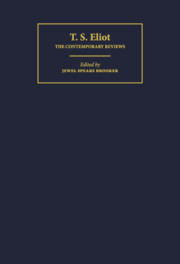Book contents
- Frontmatter
- Contents
- Series Editor's Preface
- Introduction
- Acknowledgments
- Prufrock and Other Observations (1917)
- Poems (1919); Ara Vos Prec (1920); Poems (1920)
- The Sacred Wood: Essays on Poetry and Criticism (1920, 1921)
- The Waste Land (1922)
- Homage to John Dryden (1924)
- Poems 1909–1925 (1925)
- For Lancelot Andrewes: Essays on Style and Order (1928, 1929)
- Dante (1929); Animula (1929); Marina (1930)
- Ash-Wednesday (1930)
- Selected Essays 1917–1932 (1932)
- Sweeney Agonistes (1932)
- The Use of Poetry and the Use of Criticism (1933)
- After Strange Gods: A Primer of Modern Heresy (1934)
- The Rock (1934)
- Murder in the Cathedral (1935)
- Collected Poems 1909–1935 (1936)
- The Family Reunion (1939)
- The Idea of a Christian Society (1939)
- East Coker (1940); Burnt Norton (1941); The Dry Salvages (1941); Little Gidding (1942); Four Quartets (1943)
- Notes Towards the Definition of Culture (1948, 1949)
- The Cocktail Party (1949, 1950)
- The Confidential Clerk (1954)
- The Elder Statesman (1959)
- Index
Murder in the Cathedral (1935)
Published online by Cambridge University Press: 10 March 2010
- Frontmatter
- Contents
- Series Editor's Preface
- Introduction
- Acknowledgments
- Prufrock and Other Observations (1917)
- Poems (1919); Ara Vos Prec (1920); Poems (1920)
- The Sacred Wood: Essays on Poetry and Criticism (1920, 1921)
- The Waste Land (1922)
- Homage to John Dryden (1924)
- Poems 1909–1925 (1925)
- For Lancelot Andrewes: Essays on Style and Order (1928, 1929)
- Dante (1929); Animula (1929); Marina (1930)
- Ash-Wednesday (1930)
- Selected Essays 1917–1932 (1932)
- Sweeney Agonistes (1932)
- The Use of Poetry and the Use of Criticism (1933)
- After Strange Gods: A Primer of Modern Heresy (1934)
- The Rock (1934)
- Murder in the Cathedral (1935)
- Collected Poems 1909–1935 (1936)
- The Family Reunion (1939)
- The Idea of a Christian Society (1939)
- East Coker (1940); Burnt Norton (1941); The Dry Salvages (1941); Little Gidding (1942); Four Quartets (1943)
- Notes Towards the Definition of Culture (1948, 1949)
- The Cocktail Party (1949, 1950)
- The Confidential Clerk (1954)
- The Elder Statesman (1959)
- Index
Summary
*"Mr. Eliot’s New Play."
Times Literary
Supplement 1741 (13 June
1935), 376.
Mr. Eliot's new work of poetic drama has moved farther from the theatre than his previous attempts and come nearer to the Church. It is written for production in Canterbury Cathedral this week. Its conventions have more in common with ritual than with the stage, as in the earliest English drama; and these conventions which he has adopted, including strong use of a chorus, are well assimilated to the whole texture. In The Rock they were often self-conscious, but here they have become subordinate, natural, appropriate. The play might be described as a poem for several voices used liturgically.
The subject covered by a title that echoes detective fiction is Thomas Becket's assassination. It is told without an obvious propagandist intention, which was not the case with The Rock. We open with Becket returning after seven years abroad, to a scene which has been prepared by a chorus of Canterbury women, who speak in strikingly simple language:
Here is no continuing city, here is no abiding stay.
Ill the wind, ill the time, uncertain the profit, certain the danger.
O late late late, late is the time, late too late, and rotten the year;
Evil the wind, and bitter the sea, and grey the sky, grey grey grey.
O Thomas, return, Archbishop; return, return to France.
But Becket, who is shown throughout as one ready for death, will not accept any warning. Tempters appear.
- Type
- Chapter
- Information
- T. S. EliotThe Contemporary Reviews, pp. 317 - 350Publisher: Cambridge University PressPrint publication year: 2004



